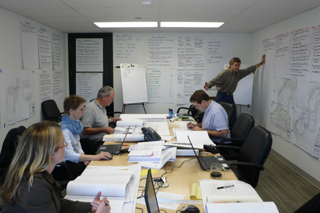
DJC.COM
February 14, 2008
Charrettes evolve to help make projects lean and green
Olympic Associates Co.

Paget
|
Until sustainable design exploded onto the scene, cost, schedule and quality were the driving criteria behind most construction projects.
Environmental, economic and social sustainability have grown in importance to owners, requiring project teams to juggle these values with the traditional triad of cost, schedule and quality.
The design profession has responded by initiating eco-charrettes and innovating sustainable design strategies. Eco-charrettes have proven successful at identifying environmental goals and associated design strategies, but have come up short in weighing these against a project’s required functions and budget.
Project teams need a better tool early in design for understanding the relationship between an owner’s values, a project’s functional requirements and the cost of proposed design solutions. The value-based design charrette is an effective tool for balancing function, environmental sustainability, and initial and life-cycle costs.
Value-based charrette

Photo courtesy of Olympic Associates Designers at a value-based design charrette try to strike an elusive balance of function, performance and cost.
|
The value-based design charrette combines the design intensity of a charrette with the function-oriented, collaborative problem-solving of value analysis to achieve that elusive balance of function, performance and cost.
Value analysis has been applied successfully to construction projects since the early 1950s. Over the decades, it has been refined by SAVE International, the professional value society, into a series of steps that function similarly to the scientific method. The steps include inquiry, speculation, analysis and development of design solutions.
A value-based design charrette typically occurs over a two- to five-day period, depending upon the complexity of the project, and can be broken up into multiple sessions over several weeks. The process frequently advances the design by one or more months.
Team members confirm project goals and program requirements, take a fresh look at facility function from a whole-systems perspective, and review an early baseline design and cost model. Proceeding from this foundation, the team identifies creative ideas to improve sustainable performance.
Ideas with merit are rigorously analyzed for architectural and engineering performance, sustainability, and initial and life-cycle cost. At the completion of the charrette, a preferred-alternative design and cost model are documented that represent the consensus agreement of the key stakeholders.
Functions first
Value analysis has been used successfully to introduce sustainable design features into office buildings, high-security correctional institutions, maintenance facilities, K-12 and higher education facilities and childcare centers, to cite a few examples.
There is an intrinsic relationship between value analysis and sustainable design, with each seeking to reliably provide the essential function through the wise use of resources now and in the future. A distinguishing feature of value analysis is a focus on identifying the functions or services a project must accomplish to fulfill its program requirements.
Analyzing the functions, whether they are sheltering occupants, conditioning space or transmitting light, moves a team’s focus from predefined solutions to an understanding of the essential services that must be rendered. This shift in focus can open up hereto unforeseen design solutions to delivering the needed function.
Avoiding budget pain
All owners or development managers want to know what their buildings will cost and that their project designs will provide the required functions. One of the major barriers to incorporating sustainable design into a project is the actual or perceived higher cost of sustainable features.
Making design decisions based on an understanding of first and life-cycle costs relative to value provided is a high priority for owners.
A shortcoming of the typical eco-charrette is that the strategies identified are not subjected to analysis within the charrette framework and time frame. Validation of ideas is left to the design team to complete in the following weeks and months.
In one case, this led to painful design and scope cuts when the estimate for a child development center came in 45 percent over budget. The eco-charrette for the project yielded well-articulated sustainable design priorities and multiple strategies to achieve a projected 40 credits for a high LEED gold rating.
While there were multiple reasons for the cost issues, including market escalation and budget omissions, had a thorough analysis of strategies been conducted during the eco-charrette, some of the pain could have been avoided.
Testing design strategies
An important step in a value-based design charrette is to technically validate alternative solutions and estimate the costs and benefits of implementation.
Concepts are researched, analyzed, priced and described in narrative and graphic form. The rigorous, real-time testing of strategies within the constraints of the charrette framework supports informed decision making.
When the function “control stormwater” was considered for a large college campus, numerous creative solutions were identified. The baseline design called for a large centralized rain garden to process stormwater piped from the parking lot.
Team members analyzed using porous pavement and decentralized rain gardens in the parking islands to “control stormwater.” While the annual maintenance cost for the porous pavement was higher, the initial cost savings from eliminating the catch basins and piping yielded a significant life-cycle cost savings.
Understanding the customer’s goals in a study of an intensive management unit at a high-security juvenile detention facility led to adding clerestory roof monitors despite the cost premium and departure from the standardized security design.
The institution’s treatment philosophy to provide as natural and normal an environment as possible helped identify the function “illuminate space.” Sunlight was identified as an important element in helping residents transition to a lower-security setting.
Achieving sustainable value
These examples illustrate how value-based design charrettes can help align owner values, functional requirements, sustainable design solutions and budget constraints.
The challenge of achieving sustainable, carbon-neutral buildings in a tight construction market will require powerful tools. Integrating the best features of eco-charrettes and the strengths of value analysis will improve our chances of success.
Value-based design charrettes offer the function-oriented, collaborative problem-solving and rigorous analysis needed to meet the challenge.
Steven Paget is a senior value analyst and sustainability consultant at Olympic Associates Co., an architecture, engineering and construction services consulting firm.
Other Stories:
- New headquarters lets firm walk the green talk
- Vancouver convention center goes for the gold
- Affordable green housing: a social, economic priority
- Reduce your footprint, starting with where you work
- Tapping a market by building green
- Let’s get pumped up about heat sharing
- New LEED standards help retailers go green
- What does sustainability mean in practice?
- When sustainability means putting people first
- Rising to the challenge of carbon neutrality
- Dead-end street to get an urban makeover
- Is LEED living up to its hype?
- How one city is getting greener
Copyright ©2009 Seattle Daily Journal and DJC.COM.
Comments? Questions? Contact us.